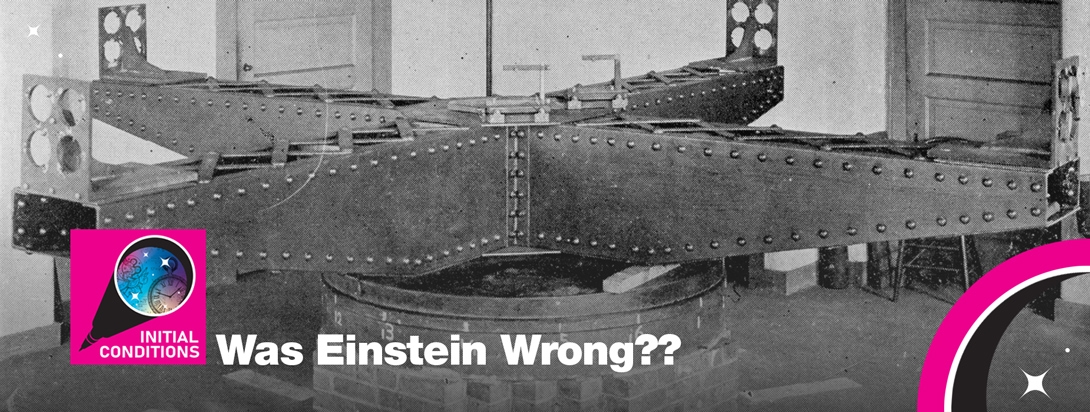
What is pseudoscience? The answer is more difficult than you might think. We can learn a lot more about what science is, how it is practiced, and what goes into producing new scientific knowledge from pseudoscience. Based on the work of historian of science Michael Gordin and two collections in the Niels Bohr Library & Archives, this episode examines pseudoscientific rejections of and elaborations on the theory of relativity. Some of the pseudoscientists we profile think that Einstein was flat-out wrong–that he missed some vital information or that his theory is simply too confusing and unintuitive to understand. Other individuals included in these collections agree with Einstein but push relativity in interesting directions. One tries to make a case for a 6,000 year old universe. Another tells us how to build a time machine to introduce Muhammad Ali to Thomas Edison. We conclude with Ralph Hartley, a practicing and accomplished scientist. Hartley was born eight years after Einstein and never accepted the theory of relativity, offering instead a much older explanation of how gravity works. Through these stories we’ll learn about what constitutes legitimate science and how it is practiced.
Speakers: Maura Shapiro and Justin Shapiro
Initial Conditions Episode 5: Crank Theories Date: August 2, 2022
JUSTIN: We're in the stacks of the Niels Bohr Library and Archives, and our associate director of library collections and services, Allison Rein, is moving--
MAURA: --as if by magic--
JUSTIN: --a long, rolling wall of books and documents as we make our way down the row in search of a special collection.
ALLISON: And it's funny, because these rolling shelves are the kind that are often moved by large, circular cranks, which is appropriate given our subject today.
(laughter)
JUSTIN: Speaking of cranks.
ALLISON: Okay, so we're here to look at something interesting, Justin. What are we looking at today?
JUSTIN: It is the Alex Harvey collection on crank theories. I prefer to call it pseudoscience. I'm not familiar with the term "crank" in physics. Maura, how widely-used is the term "crank"?
MAURA: It's not widely-used in that people aren't often talking about cranks, but it is used as someone who kind of is stuck in an outdated theory, and that's kind of a through-line for a lot of the pseudoscientists that are represented in this collection, right?
JUSTIN: Yeah, I'd say that's right, but you know, I don't know, my kneejerk reaction is that it sounds kind of derisive, and I like pseudoscience because well, it has the word science in it, and this episode is very much about the relationship between science and pseudoscience.
ALLISON: It's a bit of an editorial comment to call his collection of these materials "crank," is sort of giving you a taste of what he thought of them, just from the title of the collection alone.
MAURA: It definitely has a mocking undertone. Overtone, even.
JUSTIN: Yeah, yeah. Undertone, overtone. It's just mocking.
MAURA: I'm Maura Shapiro.
JUSTIN: And I'm Justin Shapiro.
ALLISON: And I'm Allison Rein, your tour guide through the Niels Bohr Library and Archives.
MAURA: And this is Initial Conditions, a physics history podcast.
JUSTIN: Every physics problem begins with a set of initial conditions that provide the context for physics to happen.
MAURA: Likewise, in Initial Conditions, we'll provide the context in which physics discoveries happen. We'll dive into the history behind the science of people, places, and events that have been overlooked and largely forgotten.
JUSTIN: And today, we're investigating what we can learn from what some refer to as "crank theories," but what we call pseudoscience.
MAURA: Why don't you break it down for us?
JUSTIN: All right, I'm going to lay down three initial conditions for you. Are you ready?
MAURA: I'm ready.
JUSTIN: Great. The first is new developments in physics in the 20th century. It was a big century for physics, right? And I want to talk about one of the biggest developments in the field: the theory of relativity.
MAURA: Okay...
JUSTIN: And I want to talk a little bit about how relativity reshaped the field. Not looking at traditional scientists, but looking more at pseudoscientists.
MAURA: So one initial condition is how pseudoscientists responded to the theory of relativity.
JUSTIN: Right. So that's absolutely correct. So we're going to be looking at theory of relativity and the changes it brought to the field of physics, as well as how pseudoscientists responded. Now, pseudoscience has always been a condition of doing science. Right? For as long as science has been done, there have been people who approximate science but don't get it quite right. And I want to talk a little bit about what they do and don't get right in the 20th century, especially in response to relativity.
MAURA: Okay, got it. So more specifically, the second initial condition is human tendency to try to do science but miss a little bit.
JUSTIN: That's right. So with that said, let's dive in.
MAURA: Awesome.
JUSTIN: Today, we're going to try to define the term "pseudoscience." And a good introduction to the history of pseudoscience and the definition of the term are two books by Michael Gordin, a historian of science at Princeton University. Those two books are On the Fringe, or Science Meets Pseudoscience, and The Pseudoscience Wars, on Immanuel Velikovsky and the Birth of the Modern Fringe. In those books, Gordin defines pseudoscience as a negative category. He finds it easier to define pseudoscience based on what scientists themselves refer to as pseudoscience. And what we find is that, historically, the term pseudoscience has been used differently by scientists at different times to exclude ideas and theories that they consider unscientific for various reasons.
MAURA: So studying crank theories and pseudoscience can reveal where the range is of acceptable science. What falls outside of it. And in that way, we can take the temperature of science and understand where people are struggling to fit in.
JUSTIN: And the people are at the heart of it. Science is a social activity. There are professional best practices, norms, and standards that scientists must adhere to in order to reach acceptable conclusions to other scientists.
MAURA: To differentiate between legitimate science and pseudoscience, today we'll talk about examples that clearly fall outside the boundaries of acceptable science. However, as we'll note at the end of our discussion, the borders between science and pseudoscience are permeable, and sometimes the line between science, pseudoscience, and crank theory is unclear.
JUSTIN: In addition to the two books I mentioned a moment ago, this episode is also informed by the archives at the Niels Bohr Library and Archives. In particular there are two collections that we'll talk about in a moment. One is just a collection of crank theories. These were manuscripts and books that were sent to Alex Harvey, a physicist at Queens College, but we'll come to him in a moment. The other collection is called the Ralph Hartley Papers, and that one's pretty interesting, but we'll save that for a little later in the episode. As I mentioned, one of these books by Michael Gordin is titled "The Pseudoscience Wars: Immanuel Velikovsky and the Birth of the Modern Fringe." And in that book, Gordin was interested in this guy named Immanuel Velikovsky who was a really interesting figure. He's not a household name anymore, but in the 1960s, 1970s, you might have had a better chance of mentioning him and raising a few eyebrows, especially among people who were interested in science. So I want to talk about Velikovsky, who I think is a paragon of the pseudoscientist, and who was really active in the 1950s, 1960s, and 1970s. He really burst onto the scene in a major way, with this book called Worlds in Collision, which was published in 1950. But it was debates over the publication of that book that almost made him a household name.
MAURA: What was in the book?
JUSTIN: So, Velikovsky might have considered himself to be more of a historian than a scientist, but over time, his ideas and the way that he defended his ideas changed in response to the scientific community. So Worlds in Collision was really controversial. Basically, I'll summarize the book as best I can, but Velikovsky believed that the planet Venus actually originated as a massive comet that passed really close to the Earth. And now I say Velikovsky was a historian, because he says that the transit of that comet caused all sorts of things that we can read about in the Bible.
MAURA: Oh. (laughs)
JUSTIN: The destruction of Sodom and Gamora, the story of Noah's Ark and the Great Flood. All of these, he said, were catastrophies caused by Venus disrupting the orbit of the Earth. And fire raining down from the sky, even, he said that this comet had petroleum that it deposited on the Earth, and ignited when it hit the Earth's atmosphere. And he believed that all the crises mentioned in the Bible correlated to the transit of this massive comet, that then parked itself in between Earth and Mercury as the second planet from the sun, Venus.
MAURA: Um, okay. There are a few scientific things that even I can spot. I'll bite. So did people believe him?
JUSTIN: Not initially. So you know, scientists when they're working on their ideas, they'll pass proofs of what they want to publish around, right? And the community reviews it. And Velikovsky really wanted this manuscript to be published by Macmillan. At the time, Macmillan was a leading publisher of science textbooks, and doing their due diligence, Macmillan circulated copies of the manuscript to scientists. Velikovsky also circulated a few drafts on his own. It was in this moment, the moment of what we might call peer review, that Velikovsky really kind of gained an infamy in the scientific circles. So the proofs were circulated, and scientists were unanimous in saying, "This does not track to what we know about physics or astronomy." And they pressured Macmillan not to publish this book, and eventually Macmillan did drop it. But it was picked up by Doubleday. And almost immediately became a bestseller.
MAURA: And why is that?
JUSTIN: It was the controversy behind the publication of the book that gave Velikovsky his fame.
MAURA: All press is good press.
JUSTIN: For Velikovsky, certainly. But he didn't go away. Velikovsky continued to refine his ideas, and continued to publish books on this sort of intersection of science and biblical history. And he continued to interact with scientists, although those interactions became increasingly frustrating for the scientists involved. He actually sparred with Carl Sagan at the 1974 meeting of the American Association for the Advancement of Science.
MAURA: I was curious, because I assumed comets were smaller than Venus, but I just looked up "largest comet ever discovered," and the biggest comet ever discovered is 500 trillion tons, and 137km wide. So for context, that's larger than the US state of Rhode Island. Venus (laughs) is quite a bit larger than that. The diameter of Venus is over 12,000km wide. And the mass of Venus is almost 5 x 10^21 tons. So we have never seen a comet big enough to be Venus, basically. (laughs)
JUSTIN: And you're responding in the same way that scientists of the time would have. But that didn't deter Velikovsky. Interestingly enough, he actually purchased a home in Princeton and corresponded with Einstein from time to time, until the latter's death, in the mid-1950s. But Velikovsky, he really developed these institutions and these ways of producing knowledge that would be familiar to a scientist but were oriented towards producing pseudoscience. He ended up attracting a number of people involved in the counter-culture who saw him as rebelling against establishment science, which as we talked about in the last episode, was very much a hot topic (both laugh) at the time.
MAURA: Every single episode has to have a reference to hot topic.
JUSTIN: Of course. But Velikovsky attracted a number of younger thinkers who saw him as rebelling against the establishment, and Velikovsky in journals popped up with peer review, and so Velikovsky really developed this field of study as something parallel to science, right? Something that didn't really intersect with modern science and its conclusions or its assumptions or the knowledge that it generated. But looked a hell of a lot like how science is done.
MAURA: So Velikovsky impersonated scientists by adopting the rhetorical and structural trappings that traditional science has, and through that, he gained followers. The whole time being dismissed by actual scientists as a pseudoscientist. And more than that, his dismissal of mainstream science even facilitated his rise. But his assumptions were incorrect. Still he became a popular figure, despite all scientists' work to debunk his own work.
JUSTIN: Of course. The collections we'll describe in the next couple of minutes never reached the popularity or recognizability of Velikovsky. There are some traits that the pseudoscientists share with Velikovsky, though. And perhaps most obvious is the high esteem in which they hold themselves. They also seek to make the laws of physics more intuitive. Often failing spectacularly. In trying to make physics more intuitive, they also put forward assumptions that were rejected out of hand by traditional scientists, much as Velikovsky's arguments and chronology in Worlds in Collision had been. Now, before we move on, I want to mention one more thing about the collections, and that is there is a connection between the Alex Harvey collection, this box full of these crank theories, and Emmanuel Velikovsky. Alex Harvey was the chair of the Queens College in Queens, New York, department of physics. His predecessor was Edward Thorndike, who was one of the first peer reviewers of Worlds in Colllision, of which he wrote that, "The physics is not good." Perhaps Harvey inherited Thorndike's interest in pseudoscience.
MAURA: So Harvey was not a pseudoscientist himself, merely curious about the topic?
JUSTIN: Right, and in the collections, he has these post-it notes on some of the manuscripts that say, "Throw out, crank theory." But for some reason, he just never got around to it, and so now we have them at AIP.
MAURA: And the podcast is for the better because of it. But this collection itself is pretty interesting, right, because it contains both published and unpublished materials. And generally, published materials are found in libraries, where unpublished materials are held in archives.
JUSTIN: And that's something that our tour guide, Allison Rein, associate director at the Niels Bohr Library and Archives--
MAURA: (laughs) At the American Institute of Physics.
JUSTIN: At the American Institute of Physics pointed out when I was looking through this collection. It's both books and these typewritten manuscripts.
MAURA: So why is that?
JUSTIN: Well, the books in the collection are interesting. Most of them were published by this press called Vantage Press, which is a now-defunt vanity press. And a vanity press is this place where you can pay, as an author, to get your book published. And they'll provide hard copies, paperback copies, dust jackets on the hard copies, author pictures, all that sort of stuff for a small, small fee of probably a couple thousand dollars. And so it looks like a real book, it reads like a real book, and the ideas inside are certainly real. It's just that they're not scientific. But in these cases, the pseudoscience kind of adopt rather the presentation and format of really powerful, scientific ideas. As a means to boost their own legitimacy. The Alex Harvey collection is organized chronologically, but what seems to unite the collection, and this makes sense given Harvey's background, is that first initial condition: an interest among the authors in relativity. Some defend it, most argue against it, and some adapt it to their own purposes. And there are three major themes of the manuscripts in this collection that we'd like to highlight.
MAURA: The first is that the theory of relativity isn't intuitive. It depends on complicated mathematics and is generally different from how we experience the world on an everyday basis. Second, these pseudoscientists believed that because the theory of relativity is unintuitive, it is therefore incorrect. And that they must replace it with a theory of their own. Some go back to older, outdated theories to explain the universe, while others just further complicate the math. And sometimes, the theory of relativity can actually be used with, of course, additional complicated mathematics to do miraculous things, like prove the existence of god, verify the stories of the bible, or build a time machine.
JUSTIN: Nearly all of the manuscripts in the collections, then, approach the laws of physics with the assumption that something went fundamentally wrong in the 20th century. And in turn, these writers use assumptions that run counter to contemporary physics.
MAURA: There's nothing wrong with using assumptions. Scientists do that all the time. But when scientists use assumptions, they have typically been vetted by their community, and even if they haven't, the peer review process is meant to check that scientists aren't building theories or reaching conclusions on faulty premises.
JUSTIN: The pseudoscientists here seemed to work predominantly as individuals, outside of the community and the peer review process. Their lack of membership in the scientific community, with one exception, makes what they do and how they think fundamentally different from how mainstream scientists work.
MAURA: With that introduction in mind, can you tell me a little bit about this collection?
JUSTIN: I'd be glad to. As I mentioned earlier, these manuscripts were not subject to peer review. As much as the authors hoped that Harvey or whoever else would treat them credibly. Furthermore, these theories are laden with assumptions and conclusions that would overturn physics as we know it. They exist outside of the usual business of physics, which builds on established knowledge. Let's start with the first category: theories that address the unintuitive nature of the theory of relativity.
MAURA: In 1905, Albert Einstein introduced special relativity, with the famous the laws of physics are the same in any inertial reference frame relative to one another, and that the speed of light is constant in a vacuum.
JUSTIN: Sort of like a cosmological speed limit.
MAURA: Exactly. This theory is actually kind of straightforward, and the mathematics behind it are accessible to even a second year physics student.
JUSTIN: So not really to me.
MAURA: Maybe not, but despite its simplicity for people who have a couple math classes, still it has some wacky outcomes. Two events that appear simultaneously to one observer could occur at different times to another observer in another reference frame. There's the whole time dilation effect, which leads to the twin paradox, where people could seemingly age differently, because time is a relative experience. There's also length contraction, which means that as you travel close to the speed of light, you'll look a little bit skinnier. And so these wacky effects were difficult for the old guard of physics to accept, and they were hesitant to adopt this theory.
JUSTIN: As we'll hear at the end of this episode.
MAURA: But ten years later, Albert Einstein published the general theory of relativity, which reimagines gravity as the result of a curved space time. And this was a major paradigm shift. For about 300 years, physicists had accepted the idea of gravity that Newton proposed. The mathematics of special relativity are incredibly complicated. It's dictated by a set of nonlinear differential equations which basically means that they're really hard to solve, event with advanced degrees in math. And this theory was hard to accept for many, because of how complicated--
JUSTIN: --And unintuitive.
MAURA: --it is. Exactly. And still, it led to many verified predictions, like gravitational lensing, the procession of Mercury's orbit, and gravitational red shift. Yet, it's an incomplete theory. And it's incompatible with quantum mechanics, which like general relativity, is super mathematically complicated, very unintuitive, but has also been experimentally verified.
JUSTIN: So let's talk about some of these pseudoscientists and how they respond to the theory of relativity. And I want to start with the first manuscript in the collection, titled, "The Theory of Microgravitational Forces" by Ramesh Kumar Agarwal. Undated and typed up in a bound volume, it comes in at just a few dozen pages. Agarwal writes in the introduction to his manuscript that, "My theory of microgravity is a radical theory of fundamental physics. It is a modification and furtherance of the field theory of gravity having profound impact on almost every branch of modern physics. It grossly refutes Einstein's two theories of relativity in its results. This conflict with Einstein's theories has put my theory into a vicious circle in that the exact mathematical formulation of my theory is possible with total ignorance of Einsteinian relativity, which a mind accustomed to thinking in terms of Einsteinian relativity, as most present-day physicists are likely to be, may find difficult to digest, and Einsteinian relativity can be absolutely and definitively disproved with the understanding my theory of microgravity."
MAURA: Wow, this is a pretty huge theory if he's right.
JUSTIN: Yeah, basically what he's saying is that Einstein is totally wrong and he is totally right. But the theory behind it isn't too important. He basically just says that gravity is inherent to every object that exists in space.
MAURA: Mmhmm, okay.
JUSTIN: What I want to draw attention to here is the way that Agarwal introduces his claims. He prepares physicists to be astounded by his theories, by claiming that they might be unaccustomed to such brilliant ideas since they are too deeply committed to Einsteinian relativity. Agarwal has a bone to pick with Einstein, and he concludes his theory of microgravitational forces by writing that, and I quote, "Einsteinian relativity is a miserable failure on the cosmological front."
MAURA: That's pretty harsh.
JUSTIN: It's pretty harsh, it's pretty damning, but this is a common refrain among some of the crank theorists. Take James Carter, for example. Maura, I know you read a little bit about Carter.
MAURA: Yeah, Margaret Wertheim, an Australian science writer, follows James Carter in her book "Physics on the Fringe: Smoke Rings, Circlons, and Alternative Theories of Everything." And in this book, she takes a very sympathetic approach to the so-called fringe theorist, and she explains his ideas and, more importantly, his motivations and the motivations of similar pseudoscientists.
JUSTIN: We don't need to spend too much time on Carter. Check out the book Maura recommended by Margaret Wertheim. Carter and Agarwal both openly scorn Einstein. This is of course an unusual and uncommon trait when talking about the legitimate scientific community. Scientists often avoid ad hominem attacks and discuss ideas in cordial and collegial manners. But ad hominems, or at least harsh criticism, directed towards individuals rather than their ideas is common pseudoscientists. The Niels Bohr Library and Archives has what may be the only copy of a James Carter manuscript in any known library. Carter only published ten copies of his manuscript, as he writes on the copyright page. This book is titled "Why Einstein was an Ignorant Fool." But perhaps due to spatial limitations, the title as printed on the spine reads, "Why Einstein was an Ignorant F."
MAURA: Okay Justin, that's not exactly the whole title. The full title is, "Why Einstein was an Ignorant Fool: How Einstein, Being Ignorant of Today's of Experimental Physics Was Able to Fool the World into Believing Many Impossible Things Like Infinite Fields, Massless Photons, Downward-Pointing Gravity, Equivalent Momentum in Force, and an Instantaneous, Expanding Big Bang Singularity Instead of Living Universe Duality."
JUSTIN: We can tell from the title that these pseudoscientists like to borrow terms from physics but often misuse them or interpret them in strange ways. For both Agarwal and Carter, there are attempts to use language to put a veneer of legitimacy over their work.
MAURA: In Carter's work, he looks at the quantum level, stating that traditional methods of atomic physics are inaccurate. He proposed that instead, there's something called circlons, which in his mind make more sense. And this is actually similar to an older idea of how the universe worked pre-quantum mechanics. And this was held by a lot of the 19th century scientists like Lord Kelvin or Peter Guthrie Tait. Although I'm not entirely sure that Carter is aware of that. But this is another common pattern in fringe and crank theories. A reversion to much, much older understandings of physics.
JUSTIN: That's right. And I said a moment ago that we're not going to spend too much time on Carter, although it turns out that he's a really interesting figure in his own right. And I will say that his book does feature some nice drawings of these little devil-like creatures observing photons from above and below on a tower, which he handily labeled "Jefferson Tower." The back cover illustrator has also taken care to give them all different color shoes.
MAURA: A nice touch.
JUSTIN: A nice touch, yeah.
MAURA: Agarwal and Carter scorn Einstein, and they revert back to the "good ol' days" when Newton ran the show.
JUSTIN: So Agarwal and Carter argue that Eintsteinian relativity is too unintuitive to make sense. They offer alternative theories of physics in its stead, but in looking through the Harvey collection, I came across one fringe theorist who, in his attempt to come up with a better set of physical laws than Einstein, actually created something incredibly complex and perhaps even less intuitive than relativity.
MAURA: I'm excited to hear what that is.
JUSTIN: So it's all in the title. In 1990, Dante S. Cusi published "Experiment and Logic: The Science of Interpretational Physics" with Vantage Press. And the book features a really interesting picture of Dante S. Cusi on the back cover, where he looks a lot like Junior Soprano from the The Sopranos?
MAURA: I have not seen the show.
JUSTIN: It is one of my favorite TV shows. I've seen it probably six or seven times, and believe me, he looks like one of these main characters. But that's not important today. What the dust cover reveals, in addition to this great picture of Dante S. Cusi, is that he too believed that Einstein was wrong. Unlike [Carter] and Agarwal, however, Cusi believed that Newton too might have been incorrect. And on this dust jacket, he asks a few leading questions like, "Were Newton and Einstein wrong? Are their theories based on false assumptions about the nature of matter, energy, space and time? And what do those mysterious equations have to do with the real world?"
MAURA: All questions I want the answer to.
JUSTIN: Well, good luck, if you're reading this book. Cusi suggests and alternative to both classical and relativistic physics in what he calls the "interpretational physics, a commonsense approach that seeks to explain natural events in terms the human mind can grasp." Finally, this work was motivated by Cusi's inability to understand how physics explained natural phenomena. And it's important to note here that he lived through the relativistic revolution. Writing that, "When later at the university level, the teaching became centered on relativity theory and electromagnetism, my disillusionment deepened even more and became nearly an obsession. Fundamentally because I had no way of understanding why experiments turned out the way they did."
MAURA: Don't blame the physicist, blame the physics.
JUSTIN: Yeah. If you ever don't understand anything, it's probably because it's wrong and you're right. And that's what I learned from lot of these physicists.
MAURA: (laughs) If every time I was like, "I don't understand it, physics must be wrong," during a physics class... I would have so, so, so many books published by Vantage Press.
JUSTIN: Yeah. Well it's like $2-5000 to publish with them, and they also don't exist anymore.
MAURA: A missed opportunity, then.
JUSTIN: Yeah, I'm sure there are other vanity presses that you can find to put out your ideas.
MAURA: (laughs) So back to Cusi.
JUSTIN: Back to Cusi. So he, you know, this interpretational physics, he tries for a different theory, and then relativity and classical physics. And you know this is indicated by him saying that Newton and Einstein were maybe wrong. So let's hear what Cusi's ideas are in his own words. In this book, Mr. Cusi argues that energy is matter. That a single energy system, the "imus," pervades the entire universe, and that there exists a fundamental order in nature that unifies the most seemingly-diverse phenomena. In that way, Cusi's model is anything but common sense, but more importantly, we should remember here that Cusi was responding to the relativistic revolution. He wrote that he encountered it during college, and its unintuitiveness had bothered him ever since.
MAURA: So Justin, we talked about how relativity isn't intuitive, and because of that, it must be incorrect. But you've also mentioned how some pseudoscientists actually utilize relativity to prove the existence of a god or to perform miracles.
JUSTIN: It's really an amazing thing, the way that they understand relativity. And that gets into the third category that you mentioned earlier, and that is, there are some fringe theorists who use relativity to demonstrate the existence of a creator. Almost always a Christian god in their conception. So here's one example. it's a manuscript by James H. Wiborg titled, "Theoria Primarius." We see that he borrows the Latin title from the early modern period, mimicking Newtown's "Principia Mathematica" from 1687. And thank you Maura, you corrected me on my pronunciation off the podcast.
MAURA: Yeah, I couldn't let Newton's words be butchered.
JUSTIN: No, no, and we'll be talking about him down the line I think in a future episode. But so I want to get it right now, and I appreciate that. And again, the language is really important here. Many of these fringe theorists borrow the style of legitimate scientific authorities, perhaps by custom, because many of these theorists are familiar with at least a little bit of the people they claim to refute, or maybe as a means to lend their work a sense of legitimacy. So let's hear it in Wiborg's own words. He writes, "This book as been written as the result of curiosity and discomfort. Curiosity about space and time, and the underlying design of the universe. Discomfort about the great and confusing complexity of this design as modern physics has attempted to describe it." And while he calls his model simple, it is once again incredibly complex and demonstrated through tedious and very difficult-to-follow mathematics.
MAURA: It's almost as if they're wrong. (laughs)
JUSTIN: Almost. But it's just really amazing how they set out to make these theories more intuitive, but it ends up backfiring in a really major way. And Wiborg closes his manuscript by writing, "In closing, dear reader, please remember that all that has been developed and presented in this paper is merely about a simple model, but this model does seem to provide a logical and rational foundation to the physics of space, time, and particles. Perhaps god does not play dice, after all."
MAURA: Which, of course, is a reference to Einstein's quote about his own discomfort with quantum mechanics.
JUSTIN: He goes on, "In our model, we have considered five dimensions. Three of space, one of time, and one of inertia. But we have failed to consider the dimension of thought or the MIND OF GOD."
MAURA: All caps. (laughs)
JUSTIN: And I say it like that because it's in all caps, exactly.
MAURA: Wow. So at this point, I'm wondering does anyone like relativity as it stands?
JUSTIN: So Einstein does have two defenders in the collection. Unlike Wiborg, they agree with the basic principles of relativity. Like Wiborg, they conclude that in fact their understandings of physics demonstrate that god is real and has authority over the universe. And the first of these defenders is someone named Barry Setterfield, and his manuscript is titled "The Velocity of Light and the Age of the Universe," published in 1982. Setterfield is somewhat well-known in the circles of creationists and skeptics. He's a young Earth creationist, taking the text of the bible as authoritative truth and believing that the universe was in fact created about 6,000 years ago. He demonstrates another trait of fringe theorists: a tendency to work backwards from certain conclusions. What we might otherwise call teleological thinking. And in this manuscript, he puts forward his theory of C decay. That is, that light does in fact travel at a constant speed across the universe, but also that constant speed has been decreasing at a uniform rate. Factoring in C decay, Setterfield argues, it's possible to date the universe back to 4125 B.C. plus or minus about 175 years either way.
MAURA: And the constant C refers to the speed of light. That's how it's represented in physics. But I do love that he uses the most fundamental principle of constants that they change.
JUSTIN: Yeah, one thing we know about constants is that they constantly change.
MAURA: (laughs) Yeah.
JUSTIN: And in this case, constantly decrease in speed. Setterfield concludes his manuscript by writing that, "It follows from scrutiny of the relevant formula that the universe is collapsing towards total destruction as a fireball, just as scripture predicts." How convenient that his math fits the biblical age of the universe so precisely. So another Einstein defender and one of my favorites is a man named Joseph Bonkowski. Bonkowski wrote the manuscript with my favorite title: "The Theory of Relativity 2, How to Build a Time Machine."
MAURA: The sequel we didn't know we needed.
JUSTIN: But are glad that we have.
MAURA: (laughs) Of course.
JUSTIN: The extent of what he owes to Einstein is indicated in the title. Bonkowski has written a sequel to the theory of relativity. So let's hear it in Bonkowski's own words. He writes in the introduction, "It is my hope with this text to prove the start of the universe, show mankind how to build a time machine, a shrink ray, turn iron into gold, solve the energy crisis, relate quantum mechanics with the start of the universe, look closer at atoms and light, make a new map of the galaxy, and also to answer many of the questions that man currently has about our universe."
MAURA: That's ambitious.
JUSTIN: It seems like a really comprehensive theory. But the methods that Bonkowski used were difficult to understand. His plan to build a time machine involved creating a black hole on Earth. And as he put it, "All we have to do to make a black hole on Earth is figure out how to add space to space or maybe square space or space to the 10th power or to the millionth power. If we have space to the power great enough to make time run backwards, then we have a large antimatter explosion similar to the one that started this galaxy."
MAURA: So like... At this point, that's not even using scientific jargon to sound legitimate. That is straight up how people talk on superhero movies. Like I'm pretty sure they quoted this in the Avengers to fake science and create wormholes or whatever.
JUSTIN: Yeah, you didn't see that Bonkowski won the Oscar for best screenplay for Marvel's The Avengers 7: The Adventures of Time Squared Man?
MAURA: You know what, I missed the Oscars this year, so.
JUSTIN: Oh. Something happened there, I don't know what. People were talking about it, though. According to Bonkowski, the way to produce a black hole is so simple it's a wonder that scientists hadn't thought of it before. He writes, "All we have to do is build a small and a large weightless room like our astronauts use in space training." Maura, you know about the weightless room that astronauts use in space training, right?
MAURA: Yeah well we're actually not supposed to talk about it. It's a secret. Some people believe that astronauts use planes that plummet down to simulate zero gravity or that astronauts train in pools, but no. There's actually like this top secret weightless room that NASA uses.
JUSTIN: Have you ever seen one of these planes?
MAURA: I'm not at liberty to discuss.
JUSTIN: Okay, gotcha. Bonkowski could write for Stranger Things season 5.
MAURA: (laughs)
JUSTIN: (clears throat) So anyway, we have these weightless rooms, and Bonkowski says, "All we have to do is then turn them both on, and the inside of the smaller room now has space plus space, or space squared, and just like a black hole, time will react differently here. We have a time machine, or a black hole, or both."
MAURA: And you know what? I love that he asks us to try it without knowing if we've created a black hole.
JUSTIN: Just try it.
MAURA: Just try it. Why not? What's the worst that could happen?
JUSTIN: Yeah, well I mean, he said a large antimatter explosion, similar to what started the universe, but whatever on that. I mean we'll be fine.
MAURA: And then we have a new universe. Like, so what?
JUSTIN: That's right. So let's hear how Bonkowski says we can use this new universe, or this black hole or time machine or both.
MAURA: Or both, yeah. (laughs)
JUSTIN: He writes, "The military could hold whole armies at peacetime until it's time to fight. A top boxer who is so good that he has beaten everybody and is thinking about retiring just because there's no one to fight can sit in one of the rooms until someone of quality comes to fight him. I know if this technology would have been here 200 years ago, I would not mind seeing Muhammad Ali fight Joe Lewis, or talking to Thomas Edison, Einstein, FDR, etc. The possibilities are endless."
MAURA: That is just so specific.
JUSTIN: (laughs) I know, it's very funny actually.
MAURA: Like all I would want for a time machine is to see Muhammad Ali and Joe Lewis fight.
JUSTIN: Right, or see Muhammad Ali talk to Thomas Edison.
MAURA: Oh, you know what, I was assuming that actually he wanted to talk to Thomas Edison, Einstein, FDR. But yeah, maybe (laughs) he thinks Muhammad Ali would get along with them too. Who's to say?
JUSTIN: Yeah. He writes, "I would not mind seeing Muhammad Ali fight Joe Lewis, or talking to Thomas Edison, Einstein, FDR, etc." I don't know what Muhammad Ali and Thomas Edison would have to say to each other, but...
MAURA: (laughs)
JUSTIN: What took me by surprise is that Bonkowski's fascinating manuscript ends with a discourse on the nature of god, and how his ideas about relativity, cosmology, and the laws of physics actually demonstrate that it's possible to unify with god. But I want to highlight again some of the themes here, and make a case for why collections like these matter.
MAURA: So the first theme is that there's an emphasis on the theory of relativity with most of the authors denying that it's true or valid.
JUSTIN: In many cases, the authors propose alternative theories that really just make sense. Of course, I'm kidding.
MAURA: Yeah. (laughs) I got it.
JUSTIN: Yeah good, thank you. Now someone like Dante Cusi, who went to school as relativity became accepted among scientists, shows how it takes time for new paradigms to become standard knowledge, but there are other authors here who continue to maintain that Einstein just doesn't make sense.
MAURA: And then the second theme is that in those cases, these fringe thinkers put together new theories that they find more acceptable.
JUSTIN: This is an attempt at legitimate science, but one that would never pass peer review, because the assumptions are too outlandish. Peer review exists to allow some degree of flexibility. Some new ideas and questions need to be addressed, otherwise how does science continue to evolve? But peer review also filter out theories that deviate too much from accepted knowledge.
MAURA: Some of these authors even work backwards from their conclusions. This is especially apparent in the cases of those authors who want to use the laws of physics to prove the existence of god.
JUSTIN: Bonkowski is an outlier here, because he doesn't use math, but Wiborg and Setterfield want to defend a Christian cosmology. Sometimes, they make odd assumptions to do so, such as Setterfield's belief in a uniformly-decaying speed of light. So these are the three themes of the Alex Harvey collection: fundamental disagreement with Einstein, for the most part, attempts to build simpler, more intuitive models that often backfire, and using the language and methodologies of physics to work backwards from conclusions. So that's a bit on the fringe thinkers. These are folks who, for the most part, lacked formal scientific training. I think Agarwal might be an exception. But there's another collection at the NBL Archives that was created by an actual, practicing scientist named Ralph Hartley.
MAURA: Who was Ralph Hartley?
JUSTIN: Hartley was an electronics researcher who contributed to the emergence of information theory. Most of his career was spent working for Bell Labs. He was born in 1888, just nine years after Albert Einstein. As a consequence, during his education and career, he lived through the era when Einstein's theories of relativity emerged, and then over time became the consensus understanding among physicists. But Hartley never accepted that consensus. He was not convinced that Einstein's ideas made sense. Instead, Hartley advocated for the older idea of a luminiferous ether, which was commonly accepted in the 19th century as an explanation of how light propagated through empty space. He never abandoned that idea, even while after relativity became the mainstream.
MAURA: What's interesting is that he was born one year after a famous experiment, the Michelson–Morley experiment, which ultimately proved that light travels in a vacuum. But even the creators of the Michelson–Morley experiment held firmly to the idea of the luminiferous ether. Up until that point, there were no waves without mediums. Waves were defined as disturbances in a medium, so light which physicists had observed, act as a wave, would naturally travel in a medium. Saying light traveled without a medium would have been as nonsensical as saying a boat could float without water. It made sense, then, that it took many years for physicists to feel comfortable abandoning the luminiferous ether. Even the physicist behind the experiment that doomed any chance of an ether, Albert Michelson, never gave up on its existence. But a newer wave of physicists in the 1900s felt no loyalty to the medium that was never observed. And they were comfortable moving forward without it. Which is good, because there's no evidence for it.
JUSTIN: Right. And with Einstein, it's not as though a new scientific idea just popped into his head and then was immediately was adopted by everyone. The scientific community vets, critiques, more often criticizes, and helps strengthen the original idea. It's a social process. But for something as revolutionary as relativity, it took a generational shift to really become established knowledge. And I want to stress here that Hartley was not a fringe scientist just because he held onto the idea of the luminiferious ether. Calling him so would denegrate the important work that he did in the field of electronics and information theory. But he does show what happens when scientific theories move beyond scientists. At the end of his career, Hartley stubbornly held onto the idea of the ether and continued trying to convince his colleagues that Einstein was wrong.
MAURA: It strikes me that he was part of the generation that embraced relativity, and he still would have been early in his physics career as Einstein's work gained traction. So when did he start to take issue with relativity?
JUSTIN: The first evidence of Hartley's disagreement with the theory of relativity comes from a heavily-editied technical report dating to 1928. On the manuscript, in his handwriting, he referred to the theory of relativity, writing, "Such an identity would probably not have been arrived at by a priori reasoning. To that extent, then we are justified in saying that such a physical interpretation of the assumed equations is not in accord with our intuitive ideas. To the extent that this condition exists regarding the physical interpretation of the equations, this picture of the nature of the universe to which they lead is unsatisfactory."
MAURA: What Hartley would develop and continue promoting until his death in 1970 was a mechanical view of gravity. One which placed the ether firmly at the center of the question of how bodies in space interacted. Rendering action at a distance unnecessary.
JUSTIN: Hartley held fast to the older ideas of Newtonian mechanics and James Clerk Maxwell's electromagnetic models. He believed that relativity was an unnecessary and incorrect model.
MAURA: What's interesting with... James Clerk Maxwell believed in the ether when he made his electromagnetic models. But they held up even without the ether. So it was like an interesting battle, because people were like, "Well, Maxwell believed in the ether and he made these correct equations." And then realizing that the equations don't need the ether to be successful.
JUSTIN: So these are older ideas and ones that are not rendered totally unuseful for physics or wrong, by the theory of relativity. But they're what Hartley stubbornly held onto, in defense of the ether, against mounting evidence of the accuracy of the theory of relativity. And over the next several decades, Hartley refined the ether model, referring to it in his later work as a "turbulent, dissipationless liquid." Still this was the same ether of the 19th century. Just with some refining of the mathematics behind it. And throughout the 1940s, 50s, and 60s, Hartley continued trying to publish his conclusions in several leading journals. Rarely reaching the peer review stage and often being turned down by the journal editors. Here's one response from John Tate, who in 1946 was the editor of the Physical Review. He wrote to Hartley, "This reversion to a mechanical ether theory throws out all the other known successes of Maxwell's theory and special relativity for the sake of non-linear terms. It seems to me that the non-linearities, if desired, could be introduced into Maxwell's equations without invoking the awkward ether and without dragging it in the unwanted first type terms."
MAURA: And the non-linear first type things are like mathematical jargon, if you're wondering what he's talking about there.
JUSTIN: Right. And that's right. What Tate is saying is that Hartley's theories are too antiquated.
MAURA: Yeah. And journals act as arbiters of science for better or worse. They say what gets published and what doesn't. In our last episode, we talked about how some papers were prevented from being published, that may have been beneficial for the science community. But scientific journals also prevent papers with faulty premises from dispersing on equal footing with other, valid theories.
JUSTIN: Despite being blocked by the journals that he tried to publish his theories in, Hartley did find some allies in the scientific community. But by the 1950s, the new relativistic paradigm was established, and general relativity wasn't going anywhere. Upon submitting another draft of his ideas to the Physical Review in 1953, Hartley received a strongly-worded rejection from the editors, who wrote, "I would not advise the Physical Review to reopen now a discussion on relativity, especially when the alternative theory proposed in this paper remains so vague and imprecise. The author proposes an incompressible, non-linear ether. This means an infinite velocity of propagation for longitudinal waves, which has never been observed, and a non-linearity has never been observed either." Another editor wrote, "These articles do not warrant publication in the Physical Review. The author, misunderstanding results of (Ive's 44:57) campaign against the Lorentz transformation and the special theory of relativity, mistakenly argues that we must return to classical mechanics for a relativity principle. Thus, based on a misunderstanding nurtured by Ive's stubborn fight against Lorentz and Einstein, the author proposes a step which would throw theoretical physics well back into the past century.
MAURA: Which is perfect, if you're a pseudoscientist who likes time traveling.
JUSTIN: Like Joseph Bonkowski.
MAURA: Exactly.
JUSTIN: The names aren't so important here. What is important is that this second journal editor is pointing out that Hartley was holding on stubbornly to antiquated science, science from, as he points out, the past century. Hartley finally had a chance to present his theory to broader audience in 1959, four years after Einstein's death, when his paper, "A mechanistic theory of extraatomic physics," was published in Philosphy of Science. The title of the journal is important here. In a number of their responses, the editors of physics journals suggested that Hartley's ideas might be better-suited for a philosophical journal, rather than journals that published the most recent and cutting-edge research in physics.
MAURA: So he finally got published. how were his ideas received?
JUSTIN: Hartley's publication was well-received by a number of individuals, as attested by the fact that he had a number of letters from people around the world celebrating how his theories overcame Einstein, who was wrong, of course.
MAURA: Of course.
JUSTIN: And he gained some recognition for this rejection of general relativity. Still, the scientific community ignored Hartley's mechanistic model, whereas more scientists seemed willing to engage with Hartley, at least, on the matter in the 1930s and 1940s. By the late 1950s, the relativistic theory was dominant. Seeking some comments on his research, Hartley sent the manuscript to George Thompson, son of JJ Thompson. The younger Thomspon quickly and briefly replied, "Thank you very much for your letter and reprint. The scheme you suggest has possibilities, and I wish I had time to look into it. Alas, there are so many things to do in a limited day."
MAURA: That's very polite.
JUSTIN: A very polite, very British response. Hartley was never a healthy man, and was prone to what he referred to in his letters as, "nerve exhaustion," that caused him to be laid up for months at a time. He died in 1970, likely holding fast to his mechanistic understanding of the universe.
MAURA: In Hartley, we have an example of an accomplished scientist who couldn't accept a new scientific paradigm. He held fast to the older mechanistic theories of the universe and tried unsuccessfully to update them to account for relativity. Hartley's theories would have been acceptable in the late 19th century, maybe even cutting edge. But by the mid 20th century, the ether theory was long out of fashion. When remaining committed to an antiquated scientific theory, even accomplished scientists like Hartley can do pseudoscience.
JUSTIN: Fringe thinkers aren't just oddities. They can help us understand what works int eh scientific method and how it functions to both exclude fringe theories while pushing the field of physics forward. Peer review and the social component of doing science doesn't always work perfectly, but it has been pretty good overall at answering questions about the natural world. In fact, its structures are enviable enough to be borrowed and reproduced by these fringe theorists, who try to have physicists in good standing review their work and perhaps even help them refine their ideas. Even the language and methods that scientists use are borrowed by by fringe thinkers.
MAURA: Thank you so much for joining us today.
JUSTIN: To learn more about our discussion and find related photographs, blog posts, and transcripts for this episode, check out our website at AIP.org/initialconditions, or click the link in the episode description.
MAURA: Next week, we'll hear about some inspiring women in science who have been left out of the historical narrative. And we're joined by author Olivia Waite, who is bringing their stories to life.
WAITE: Sometimes the imagination is the best way we have of connecting with a past that we don't have access to.
MAURA: Also a shout out today to our tour guide and the Associate Director of Library Collections and Services at the Niels Bohr Library and Archives, Allison Rein.
JUSTIN: This episode was created, researched, and written by Maura Shapiro and Justin Shapiro.
MAURA: Allison Rein is our executive producer, with audio production and editing by Kerry Thompson.
JUSTIN: Special thanks to the wonderful staff of NBLA and CHP for supporting us in all our research needs.
MAURA: Initial Conditions is generously sponsored by the Alfred P. Sloan Foundation.
JUSTIN: I'm Justin Shapiro.
MAURA: And I'm Maura Shapiro, no relation.
JUSTIN: And you've been listening to Initial Conditions.
VOICEOVER: From the Niels Bohr Library and Archives at the American Institute of Physics.
Interview of Arlo Landolt by David DeVorkin on 1996 October 31, Niels Bohr Library & Archives, American Institute of Physics, College Park, MD USA, www.aip.org/history-programs/niels-bohr-library/oral-histories/5922
Landolt discusses how Worlds in Collision was advertised and made available to the general public. Landolt goes on to describe the different approaches to Velikovsky that were taken by Harlow Shapely and Cecilia Payne-Gaposchkin. He also discusses organizing the 1974 AAAS panel.
Interview of Ivan King by David DeVorkin on 1977 July 18, Niels Bohr Library & Archives, American Institute of Physics, College Park, MD USA, www.aip.org/history-programs/niels-bohr-library/oral-histories/4706-1
In this interview, King discusses organizing the 1974 AAAS panel featuring Velikovsky and Sagan. King ended up presiding over that panel, ensuring that despite the tension in the room all parties involved conducted themselves professionally. King discusses the animosity the Velikovskians felt towards the established scientists on the panel.
Velikovsky, Immanuel. Worlds in Collision, Delta edition. New York: Dell Publishing Co., Inc., 1965. Available on the Internet Archive at https://archive.org/details/B-001-014-474/page/n5/mode/2up (accessed August 16th, 2022).
A free version of a later edition of Worlds in Collision. Even before it was published in 1950, Worlds in Collision sparked a major debate in the scientific community about how to address popular fringe science that would last for decades.
To find out more about Velikovsky and pseudoscience, check out the bibliography for this episode's blog post or look at the Show Notes section below.
Kerry Thomspon of Thompson House Productions produced this show. Allison Rein is executive producer. Initial Conditions: A Physics History Podcast is generously sponsored by the Alfred P. Sloan Foundation.
Sources and Collections Used
Alex Harvey collection on crank theories. American Institute of Physics, Niels Bohr Library & Archives, College Park, MD 20740, USA.
Gordin, Michael D. On the Fringe: Where Science Meets Pseudoscience. New York: Oxford University Press, 2021.
Gordin, Michael D. The Pseudoscience Wars: Immanuel Velikovsky and the Birth of the Modern Fringe. Chicago: University of Chicago Press, 2012.
Ralph V. L. Hartley papers, 1920-1970. American Institute of Physics, Niels Bohr Library & Archives, College Park, MD 20740, USA.
Velikovsky, Immanuel. Worlds in Collision, Delta edition. New York: Dell Publishing Co., Inc., 1965. Available on the Internet Archive at https://archive.org/details/B-001-014-474/page/n5/mode/2up (accessed August 16th, 2022).



















